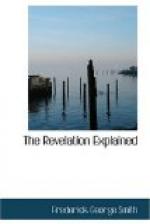15. And the seventh angel sounded; and there were great voices in heaven, saying, The kingdoms of this world are become the kingdoms of our Lord, and of his Christ; and he shall reign for ever and ever.
16. And the four and
twenty elders, which sat before God on
their seats, fell upon their
faces, and worshipped God,
17. Saying, We give thee
thanks, O Lord God Almighty, which art,
and wast, and art to come;
because thou hast taken to thee thy
great power, and hast reigned.
18. And the nations were angry, and thy wrath is come, and the time of the dead, that they should be judged, and that thou shouldest give reward unto thy servants the prophets, and to the saints, and them that fear thy name, small and great; and shouldest destroy them which destroy the earth.
19. And the temple of God was opened in heaven, and there was seen in his temple the ark of his testament: and there were lightnings, and voices, and thunderings, and an earthquake, and great hail.
The seventh angel that here sounded is the third woe-angel, and according to the description before us, ushers in the general judgment. When the temple of God was opened that this mighty event might take place on earth, there were “lightnings, and voices, and thunderings, and an earthquake, and great hail.” Wondrous commotions took place in the world, for kingdoms and empires were all overthrown, and Jesus Christ was the only king remaining, and his mission was to raise the dead that they might be judged, to give reward to the prophets and saints, and to banish with everlasting destruction those that corrupted the earth. The description itself is too plain to need further comment.
“The temple of God” that was opened in heaven is to be understood as symbolical (as explained in chap. 6:9), and not literal. In other words, the heavenly world appeared to John symbolized after the sanctuary of the temple on earth. Chap. 15:5-8; 16:1, 7, 17, etc. This is proved clearly by the fact that, when the real heaven, the future home of the redeemed, is described, John says, “I saw no temple therein.” Chap. 21:22.
Before dismissing the visions of this chapter, I wish to call attention to one more point hitherto referred to—that of parallelism and contrast. While we have the history of the church apostate described by the treading down of the holy city, we have also, in immediate contrast and running parallel therewith, a history of the true church existing during the same period of twelve hundred and sixty years, although it was in a sackcloth state. And while the reign of Protestantism is described as a period during which the two witnesses were in one sense dead, we have in immediate contrast a history of the last great reformation, in which the spirit of life from God again enters these same witnesses, and they stand upright on their feet, to the consternation of all their adversaries. Amen.




